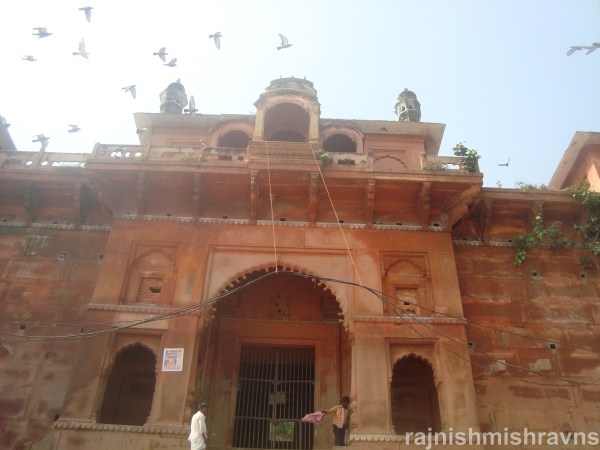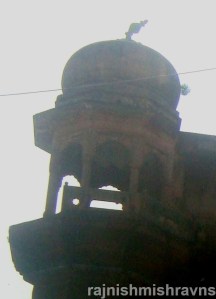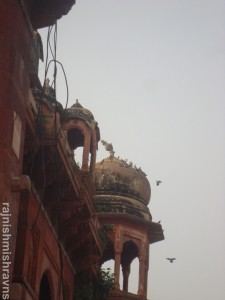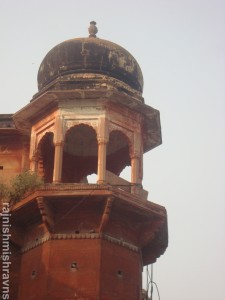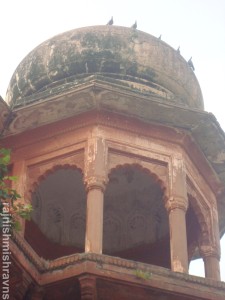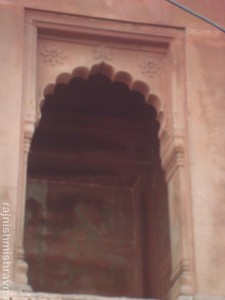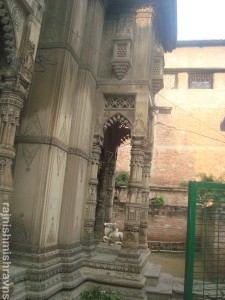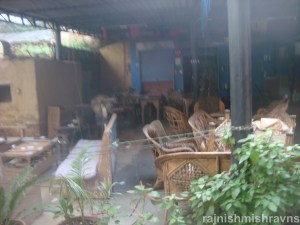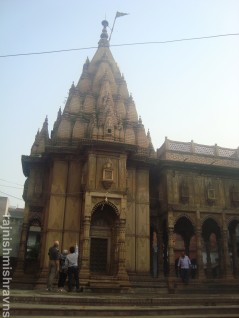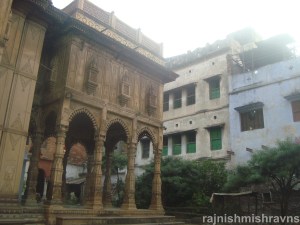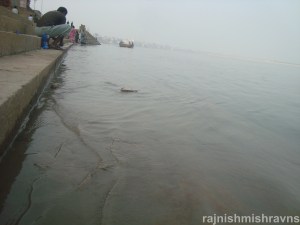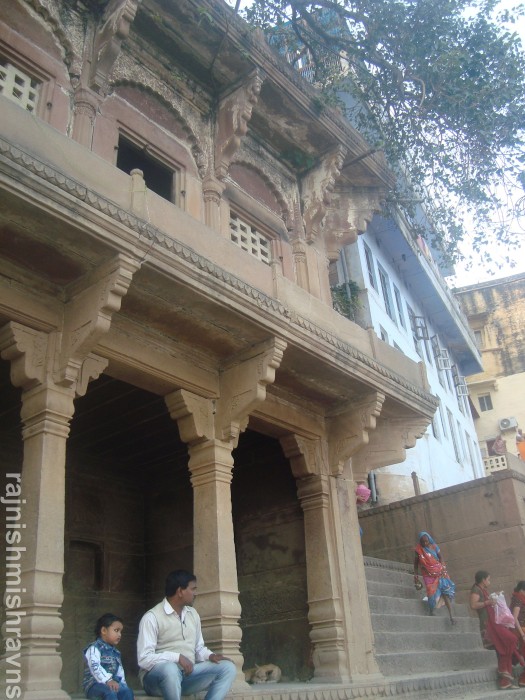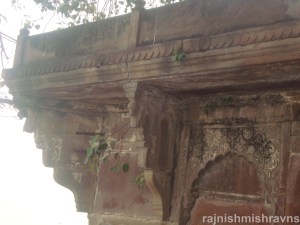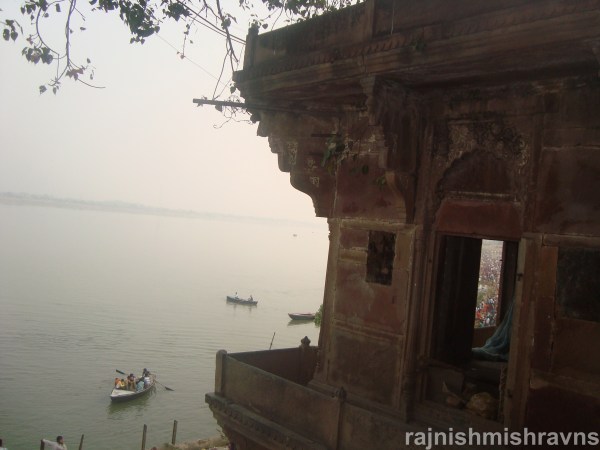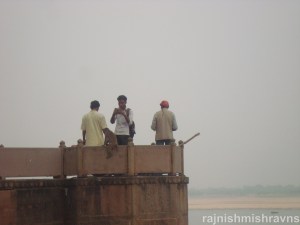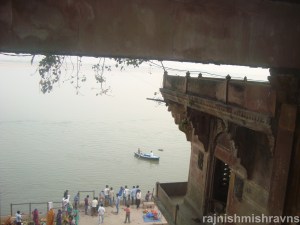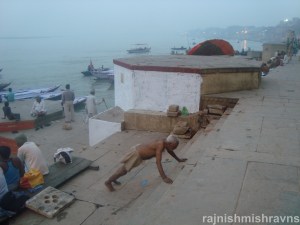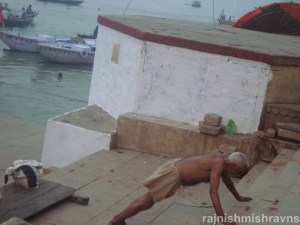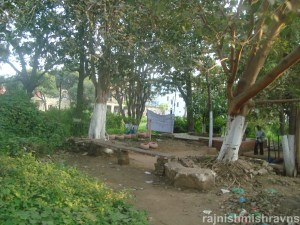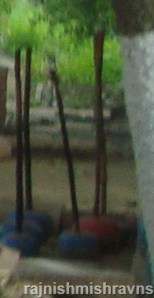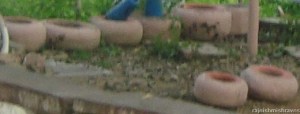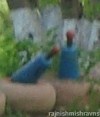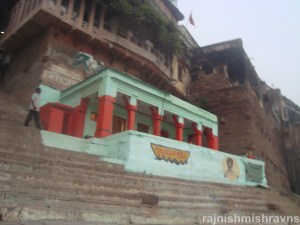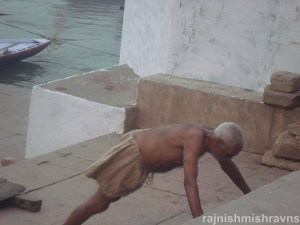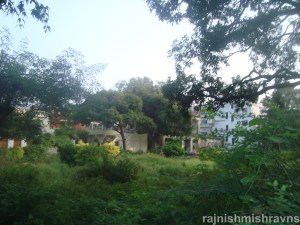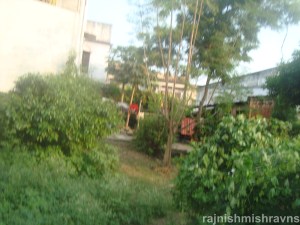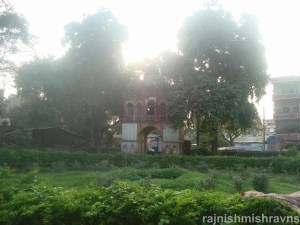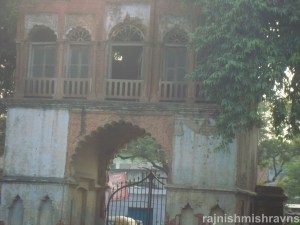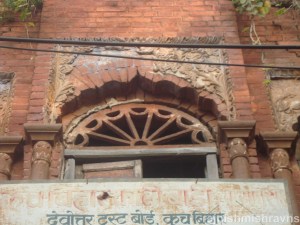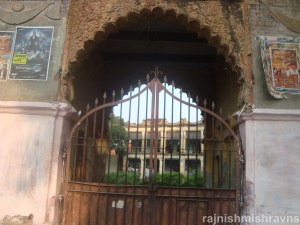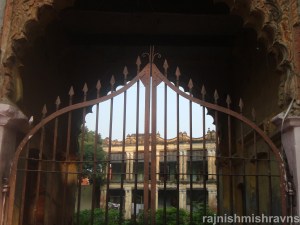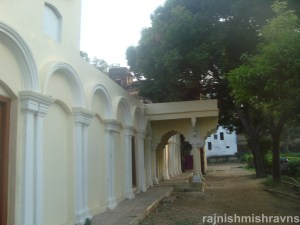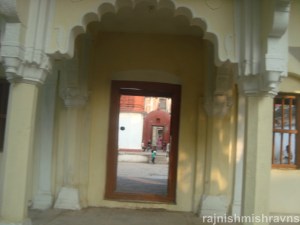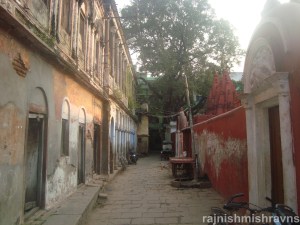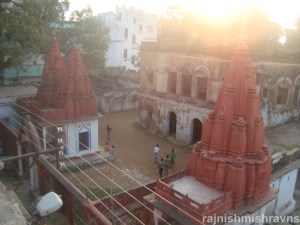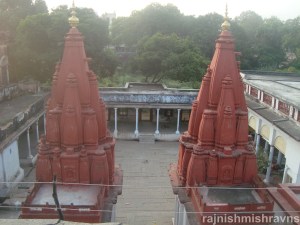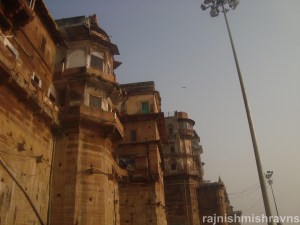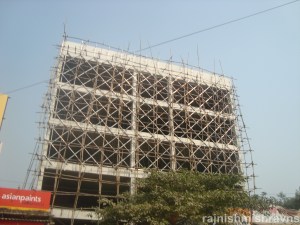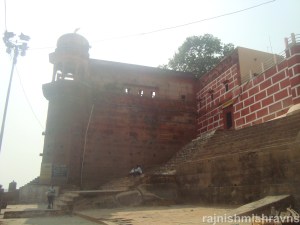 Look at the famous Palace of the Kings of Kasi which is known by its association with the revolutionary King: Chet Singh. This is how it appears to someone looking at it from Shivala Ghat. Before we look closer, it’d be better if something is mentioned here about the king whose name the ghat and the palace bear. Raja Chet Singh was the person whose forefathers were given the title of Raja and the whole Banaras region in their domain. His nominal head was the Nawab of Oudh but the British East India Company was his real master.
Look at the famous Palace of the Kings of Kasi which is known by its association with the revolutionary King: Chet Singh. This is how it appears to someone looking at it from Shivala Ghat. Before we look closer, it’d be better if something is mentioned here about the king whose name the ghat and the palace bear. Raja Chet Singh was the person whose forefathers were given the title of Raja and the whole Banaras region in their domain. His nominal head was the Nawab of Oudh but the British East India Company was his real master.
Warren Hastings, the Governor General in those days, wrote in his account of the events of August 1781, that the Raja was arrested on the sixteenth and he had offered no resistance. Correspondence of a very civil and polite nature took place between the Raja and the Governor General and all appeared to be normal at surface. Two companies of grenadier sepoys were deployed at the Raja’s Shivala residence.
They had carried no ammunition with them. Why? That remains a mystery. Hastings’s narrative of the events is as follows:
The guard placed over the Rajah consisted of two companies of grenadier sepoys, as above mentioned, from Major Popham’s detachment, commanded by the officers already named, who were Rationed in an enclosed square, which surrounded the apartment where the Rajah was. The Resident’s guard had returned with him. It now appeared that these troops had taken no ammunition with them. Major Popham sent another company of sepoys under an officer, with ammunition to reinforce and support the first party. When the latter arrived at the Rajah’s house, they found it surrounded, and all the avenues blockaded, by a multitude of armed men, who opposed their passage. The minds of this tumultuous assembly becoming soon inflamed, some of them began to fire upon the sepoys within the square, and immediately, as if this had been the concerted signal, made an instantaneous and fierce attack on the sepoys, who, wanting their accustomed means of defense, were capable of making but a feeble resistance, and fell an easy sacrifice to the superior number of their assailants, who Cut almost every man of this unfortunate party to pieces. The officers, it is supposed, were the first victims to their fury, but not until they had, by astonishing efforts of bravery, and undismayed amidst the imminent dangers which surrounded them, involved a much superior number of their enemies in their fate… In the midst of this confusion the Rajah found means to escape through a wicket which opened to the river ; and the banks being exceedingly steep in that place, he let himself down by turbans tied together, into a boat which was waiting for him, and conveyed him to the opposite shore. (pp. 40-42)
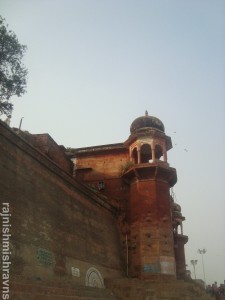 The people of Kasi made a couplet on the occasion. I remember it roughly as:
The people of Kasi made a couplet on the occasion. I remember it roughly as:
Hathi pe hauda, ghode pe jeen,
Jaan bacha bhaag gaye Waren Hesteen.
[Howdah on elephants, saddle on horse,
Ran away to save life Warren Hastings.]
Before we continue, I must paste Jayshankar Prasad’s short story गुंडा that has been taken from <http://www.hindisamay.com/kahani/jaishankar-prasad-stories/gunda.htm> here:
वह पचास वर्ष से ऊपर था। तब भी युवकों से अधिक बलिष्ठ और दृढ़ था। चमड़े पर झुर्रियाँ नहीं पड़ी थीं। वर्षा की झड़ी में, पूस की रातों की छाया में, कड़कती हुई जेठ की धूप में, नंगे शरीर घूमने में वह सुख मानता था। उसकी चढ़ी मूँछें बिच्छू के डंक की तरह, देखनेवालों की आँखों में चुभती थीं। उसका साँवला रंग, साँप की तरह चिकना और चमकीला था। उसकी नागपुरी धोती का लाल रेशमी किनारा दूर से ही ध्यान आकर्षित करता। कमर में बनारसी सेल्हे का फेंटा, जिसमें सीप की मूठ का बिछुआ खुँसा रहता था। उसके घुँघराले बालों पर सुनहले पल्ले के साफे का छोर उसकी चौड़ी पीठ पर फैला रहता। ऊँचे कन्धे पर टिका हुआ चौड़ी धार का गँड़ासा, यह भी उसकी धज! पंजों के बल जब वह चलता, तो उसकी नसें चटाचट बोलती थीं। वह गुंडा था।
ईसा की अठारहवीं शताब्दी के अन्तिम भाग में वही काशी नहीं रह गयी थी, जिसमें उपनिषद् के अजातशत्रु की परिषद् में ब्रह्मविद्या सीखने के लिए विद्वान ब्रह्मचारी आते थे। गौतम बुद्ध और शंकराचार्य के धर्म-दर्शन के वाद-विवाद, कई शताब्दियों से लगातार मंदिरों और मठों के ध्वंस और तपस्वियों के वध के कारण, प्राय: बन्द-से हो गये थे। यहाँ तक कि पवित्रता और छुआछूत में कट्टर वैष्णव-धर्म भी उस विशृंखलता में, नवागन्तुक धर्मोन्माद में अपनी असफलता देखकर काशी में अघोर रूप धारण कर रहा था। उसी समय समस्त न्याय और बुद्धिवाद को शस्त्र-बल के सामने झुकते देखकर, काशी के विच्छिन्न और निराश नागरिक जीवन ने, एक नवीन सम्प्रदाय की सृष्टि की। वीरता जिसका धर्म था। अपनी बात पर मिटना, सिंह-वृत्ति से जीविका ग्रहण करना, प्राण-भिक्षा माँगनेवाले कायरों तथा चोट खाकर गिरे हुए प्रतिद्वन्द्वी पर शस्त्र न उठाना, सताये निर्बलों को सहायता देना और प्रत्येक क्षण प्राणों को हथेली पर लिये घूमना, उसका बाना था। उन्हें लोग काशी में गुंडा कहते थे।
जीवन की किसी अलभ्य अभिलाषा से वञ्चित होकर जैसे प्राय: लोग विरक्त हो जाते हैं, ठीक उसी तरह किसी मानसिक चोट से घायल होकर, एक प्रतिष्ठित जमींदार का पुत्र होने पर भी, नन्हकूसिंह गुंडा हो गया था। दोनों हाथों से उसने अपनी सम्पत्ति लुटायी। नन्हकूसिंह ने बहुत-सा रुपया खर्च करके जैसा स्वाँग खेला था, उसे काशी वाले बहुत दिनों तक नहीं भूल सके। वसन्त ऋतु में यह प्रहसनपूर्ण अभिनय खेलने के लिए उन दिनों प्रचुर धन, बल, निर्भीकता और उच्छृंखलता की आवश्यकता होती थी। एक बार नन्हकूसिंह ने भी एक पैर में नूपुर, एक हाथ में तोड़ा, एक आँख में काजल, एक कान में हजारों के मोती तथा दूसरे कान में फटे हुए जूते का तल्ला लटकाकर, एक जड़ाऊ मूठ की तलवार, दूसरा हाथ आभूषणों से लदी हुई अभिनय करनेवाली प्रेमिका के कन्धे पर रखकर गाया था-
‘‘कहीं बैगनवाली मिले तो बुला देना।’’
प्राय: बनारस के बाहर की हरियालियों में, अच्छे पानीवाले कुओं पर, गंगा की धारा में मचलती हुई डोंगी पर वह दिखलाई पड़ता था। कभी-कभी जूआखाने से निकलकर जब वह चौक में आ जाता, तो काशी की रँगीली वेश्याएँ मुस्कराकर उसका स्वागत करतीं और उसके दृढ़ शरीर को सस्पृह देखतीं। वह तमोली की ही दूकान पर बैठकर उनके गीत सुनता, ऊपर कभी नहीं जाता था। जूए की जीत का रुपया मुठ्ठियों में भर-भरकर, उनकी खिडक़ी में वह इस तरह उछालता कि कभी-कभी समाजी लोग अपना सिर सहलाने लगते, तब वह ठठाकर हँस देता। जब कभी लोग कोठे के ऊपर चलने के लिए कहते, तो वह उदासी की साँस खींचकर चुप हो जाता।
वह अभी वंशी के जूआखाने से निकला था। आज उसकी कौड़ी ने साथ न दिया। सोलह परियों के नृत्य में उसका मन न लगा। मन्नू तमोली की दूकान पर बैठते हुए उसने कहा-‘‘आज सायत अच्छी नहीं रही, मन्नू!’’
‘‘क्यों मालिक! चिन्ता किस बात की है। हम लोग किस दिन के लिए हैं। सब आप ही का तो है।’’
‘‘अरे, बुद्धू ही रहे तुम! नन्हकूसिंह जिस दिन किसी से लेकर जूआ खेलने लगे उसी दिन समझना वह मर गये। तुम जानते नहीं कि मैं जूआ खेलने कब जाता हूँ। जब मेरे पास एक पैसा नहीं रहता; उसी दिन नाल पर पहुँचते ही जिधर बड़ी ढेरी रहती है, उसी को बदता हूँ और फिर वही दाँव आता भी है। बाबा कीनाराम का यह बरदान है!’’
‘‘तब आज क्यों, मालिक?’’
‘‘पहला दाँव तो आया ही, फिर दो-चार हाथ बदने पर सब निकल गया। तब भी लो, यह पाँच रुपये बचे हैं। एक रुपया तो पान के लिए रख लो और चार दे दो मलूकी कथक को, कह दो कि दुलारी से गाने के लिए कह दे। हाँ, वही एक गीत-
‘‘विलमि विदेश रहे।’’
नन्हकूसिंह की बात सुनते ही मलूकी, जो अभी गाँजे की चिलम पर रखने के लिए अँगारा चूर कर रहा था, घबराकर उठ खड़ा हुआ। वह सीढिय़ों पर दौड़ता हुआ चढ़ गया। चिलम को देखता ही ऊपर चढ़ा, इसलिए उसे चोट भी लगी; पर नन्हकूसिंह की भृकुटी देखने की शक्ति उसमें कहाँ। उसे नन्हकूसिंह की वह मूर्ति न भूली थी, जब इसी पान की दूकान पर जूएखाने से जीता हुआ, रुपये से भरा तोड़ा लिये वह बैठा था। दूर से बोधीसिंह की बारात का बाजा बजता हुआ आ रहा था। नन्हकू ने पूछा-‘‘यह किसकी बारात है?’’
‘‘ठाकुर बोधीसिंह के लड़के की।’’-मन्नू के इतना कहते ही नन्हकू के ओठ फड़कने लगे। उसने कहा-‘‘मन्नू! यह नहीं हो सकता। आज इधर से बारात न जायगी। बोधीसिंह हमसे निपटकर तब बारात इधर से ले जा सकेंगे।’’
मन्नू ने कहा-‘‘तब मालिक, मैं क्या करूँ?’’
नन्हकू गँड़ासा कन्धे पर से और ऊँचा करके मलूकी से बोला-‘‘मलुकिया देखता है, अभी जा ठाकुर से कह दे, कि बाबू नन्हकूसिंह आज यहीं लगाने के लिए खड़े हैं। समझकर आवें, लड़के की बारात है।’’ मलुकिया काँपता हुआ ठाकुर बोधीसिंह के पास गया। बोधीसिंह और नन्हकू से पाँच वर्ष से सामना नहीं हुआ है। किसी दिन नाल पर कुछ बातों में ही कहा-सुनी होकर, बीच-बचाव हो गया था। फिर सामना नहीं हो सका। आज नन्हकू जान पर खेलकर अकेला खड़ा है। बोधीसिंह भी उस आन को समझते थे। उन्होंने मलूकी से कहा-‘‘जा बे, कह दे कि हमको क्या मालूम कि बाबू साहब वहाँ खड़े हैं। जब वह हैं ही, तो दो समधी जाने का क्या काम है।’’ बोधीसिंह लौट गये और मलूकी के कन्धे पर तोड़ा लादकर बाजे के आगे नन्हकूसिंह बारात लेकर गये। ब्याह में जो कुछ लगा, खर्च किया। ब्याह कराकर तब, दूसरे दिन इसी दूकान तक आकर रुक गये। लड़के को और उसकी बारात को उसके घर भेज दिया।
मलूकी को भी दस रुपया मिला था उस दिन। फिर नन्हकूसिंह की बात सुनकर बैठे रहना और यम को न्योता देना एक ही बात थी। उसने जाकर दुलारी से कहा-‘‘हम ठेका लगा रहे हैं, तुम गाओ, तब तक बल्लू सारंगीवाला पानी पीकर आता है।’’
‘‘बाप रे, कोई आफत आयी है क्या बाबू साहब? सलाम!’’-कहकर दुलारी ने खिडक़ी से मुस्कराकर झाँका था कि नन्हकूसिंह उसके सलाम का जवाब देकर, दूसरे एक आनेवाले को देखने लगे।
हाथ में हरौती की पतली-सी छड़ी, आँखों में सुरमा, मुँह में पान, मेंहदी लगी हुई लाल दाढ़ी, जिसकी सफेद जड़ दिखलाई पड़ रही थी, कुव्वेदार टोपी; छकलिया अँगरखा और साथ में लैसदार परतवाले दो सिपाही! कोई मौलवी साहब हैं। नन्हकू हँस पड़ा। नन्हकू की ओर बिना देखे ही मौलवी ने एक सिपाही से कहा-‘‘जाओ, दुलारी से कह दो कि आज रेजिडेण्ट साहब की कोठी पर मुजरा करना होगा, अभी चले, देखो तब तक हम जानअली से कुछ इत्र ले रहे हैं।’’ सिपाही ऊपर चढ़ रहा था और मौलवी दूसरी ओर चले थे कि नन्हकू ने ललकारकर कहा-‘‘दुलारी! हम कब तक यहाँ बैठे रहें! क्या अभी सरंगिया नहीं आया?’’
दुलारी ने कहा-‘‘वाह बाबू साहब! आपही के लिए तो मैं यहाँ आ बैठी हूँ, सुनिए न! आप तो कभी ऊपर…’’ मौलवी जल उठा। उसने कड़ककर कहा-‘‘चोबदार! अभी वह सुअर की बच्ची उतरी नहीं। जाओ, कोतवाल के पास मेरा नाम लेकर कहो कि मौलवी अलाउद्दीन कुबरा ने बुलाया है। आकर उसकी मरम्मत करें। देखता हूँ तो जब से नवाबी गयी, इन काफिरों की मस्ती बढ़ गयी है।’’
कुबरा मौलवी! बाप रे-तमोली अपनी दूकान सम्हालने लगा। पास ही एक दूकान पर बैठकर ऊँघता हुआ बजाज चौंककर सिर में चोट खा गया! इसी मौलवी ने तो महाराज चेतसिंह से साढ़े तीन सेर चींटी के सिर का तेल माँगा था। मौलवी अलाउद्दीन कुबरा! बाजार में हलचल मच गयी। नन्हकूसिंह ने मन्नू से कहा-‘‘क्यों, चुपचाप बैठोगे नहीं!’’ दुलारी से कहा-‘‘वहीं से बाईजी! इधर-उधर हिलने का काम नहीं। तुम गाओ। हमने ऐसे घसियारे बहुत-से देखे हैं। अभी कल रमल के पासे फेंककर अधेला-अधेला माँगता था, आज चला है रोब गाँठने।’’
अब कुबरा ने घूमकर उसकी ओर देखकर कहा-‘‘कौन है यह पाजी!’’
‘‘तुम्हारे चाचा बाबू नन्हकूसिंह!’’-के साथ ही पूरा बनारसी झापड़ पड़ा। कुबरा का सिर घूम गया। लैस के परतले वाले सिपाही दूसरी ओर भाग चले और मौलवी साहब चौंधिया कर जानअली की दूकान पर लडख़ड़ाते, गिरते-पड़ते किसी तरह पहुँच गये।
जानअली ने मौलवी से कहा-‘‘मौलवी साहब! भला आप भी उस गुण्डे के मुँह लगने गये। यह तो कहिए कि उसने गँड़ासा नहीं तौल दिया।’’ कुबरा के मुँह से बोली नहीं निकल रही थी। उधर दुलारी गा रही थी’’ …. विलमि विदेस रहे ….’’ गाना पूरा हुआ, कोई आया-गया नही। तब नन्हकूसिंह धीरे-धीरे टहलता हुआ, दूसरी ओर चला गया। थोड़ी देर में एक डोली रेशमी परदे से ढँकी हुई आयी। साथ में एक चोबदार था। उसने दुलारी को राजमाता पन्ना की आज्ञा सुनायी।
दुलारी चुपचाप डोली पर जा बैठी। डोली धूल और सन्ध्याकाल के धुएँ से भरी हुई बनारस की तंग गलियों से होकर शिवालय घाट की ओर चली।
2
श्रावण का अन्तिम सोमवार था। राजमाता पन्ना शिवालय में बैठकर पूजन कर रही थी। दुलारी बाहर बैठी कुछ अन्य गानेवालियों के साथ भजन गा रही थी। आरती हो जाने पर, फूलों की अञ्जलि बिखेरकर पन्ना ने भक्तिभाव से देवता के चरणों में प्रणाम किया। फिर प्रसाद लेकर बाहर आते ही उन्होंने दुलारी को देखा। उसने खड़ी होकर हाथ जोड़ते हुए कहा-‘‘मैं पहले ही पहुँच जाती। क्या करूँ, वह कुबरा मौलवी निगोड़ा आकर रेजिडेण्ट की कोठी पर ले जाने लगा। घण्टों इसी झंझट में बीत गया, सरकार!’’
‘‘कुबरा मौलवी! जहाँ सुनती हूँ, उसी का नाम। सुना है कि उसने यहाँ भी आकर कुछ….’’-फिर न जाने क्या सोचकर बात बदलते हुए पन्ना ने कहा-‘‘हाँ, तब फिर क्या हुआ? तुम कैसे यहाँ आ सकीं?’’
‘‘बाबू नन्हकूसिंह उधर से आ गये।’’ मैंने कहा-‘‘सरकार की पूजा पर मुझे भजन गाने को जाना है। और यह जाने नहीं दे रहा है। उन्होंने मौलवी को ऐसा झापड़ लगाया कि उसकी हेकड़ी भूल गयी। और तब जाकर मुझे किसी तरह यहाँ आने की छुट्टी मिली।’’
‘‘कौन बाबू नन्हकूसिंह!’’
दुलारी ने सिर नीचा करके कहा-‘‘अरे, क्या सरकार को नहीं मालूम? बाबू निरंजनसिंह के लड़के! उस दिन, जब मैं बहुत छोटी थी, आपकी बारी में झूला झूल रही थी, जब नवाब का हाथी बिगड़कर आ गया था, बाबू निरंजनसिंह के कुँवर ने ही तो उस दिन हम लोगों की रक्षा की थी।’’
राजमाता का मुख उस प्राचीन घटना को स्मरण करके न जाने क्यों विवर्ण हो गया। फिर अपने को सँभालकर उन्होंने पूछा-‘‘तो बाबू नन्हकूसिंह उधर कैसे आ गये?’’
दुलारी ने मुस्कराकर सिर नीचा कर लिया! दुलारी राजमाता पन्ना के पिता की जमींदारी में रहने वाली वेश्या की लडक़ी थी। उसके साथ ही कितनी बार झूले-हिण्डोले अपने बचपन में पन्ना झूल चुकी थी। वह बचपन से ही गाने में सुरीली थी। सुन्दरी होने पर चञ्चल भी थी। पन्ना जब काशीराज की माता थी, तब दुलारी काशी की प्रसिद्ध गानेवाली थी। राजमहल में उसका गाना-बजाना हुआ ही करता। महाराज बलवन्तसिंह के समय से ही संगीत पन्ना के जीवन का आवश्यक अंश था। हाँ, अब प्रेम-दु:ख और दर्द-भरी विरह-कल्पना के गीत की ओर अधिक रुचि न थी। अब सात्विक भावपूर्ण भजन होता था। राजमाता पन्ना का वैधव्य से दीप्त शान्त मुखमण्डल कुछ मलिन हो गया।
बड़ी रानी की सापत्न्य ज्वाला बलवन्तसिंह के मर जाने पर भी नहीं बुझी। अन्त:पुर कलह का रंगमंच बना रहता, इसी से प्राय: पन्ना काशी के राजमंदिर में आकर पूजा-पाठ में अपना मन लगाती। रामनगर में उसको चैन नहीं मिलता। नयी रानी होने के कारण बलवन्तसिंह की प्रेयसी होने का गौरव तो उसे था ही, साथ में पुत्र उत्पन्न करने का सौभाग्य भी मिला, फिर भी असवर्णता का सामाजिक दोष उसके हृदय को व्यथित किया करता। उसे अपने ब्याह की आरम्भिक चर्चा का स्मरण हो आया।
छोटे-से मञ्च पर बैठी, गंगा की उमड़ती हुई धारा को पन्ना अन्य-मनस्क होकर देखने लगी। उस बात को, जो अतीत में एक बार, हाथ से अनजाने में खिसक जानेवाली वस्तु की तरह गुप्त हो गयी हो; सोचने का कोई कारण नहीं। उससे कुछ बनता-बिगड़ता भी नहीं; परन्तु मानव-स्वभाव हिसाब रखने की प्रथानुसार कभी-कभी कही बैठता है, ‘‘कि यदि वह बात हो गयी होती तो?’’ ठीक उसी तरह पन्ना भी राजा बलवन्तसिंह द्वारा बलपूर्वक रानी बनायी जाने के पहले की एक सम्भावना को सोचने लगी थी। सो भी बाबू नन्हकूसिंह का नाम सुन लेने पर। गेंदा मुँहलगी दासी थी। वह पन्ना के साथ उसी दिन से है, जिस दिन से पन्ना बलवन्तसिंह की प्रेयसी हुई। राज्य-भर का अनुसन्धान उसी के द्वारा मिला करता। और उसे न जाने कितनी जानकारी भी थी। उसने दुलारी का रंग उखाड़ने के लिए कुछ कहना आवश्यक समझा।
‘‘महारानी! नन्हकूसिंह अपनी सब जमींदारी स्वाँग, भैंसों की लड़ाई, घुड़दौड़ और गाने-बजाने में उड़ाकर अब डाकू हो गया है। जितने खून होते हैं, सब में उसी का हाथ रहता है। जितनी ….’’ उसे रोककर दुलारी ने कहा-‘‘यह झूठ है। बाबू साहब के ऐसा धर्मात्मा तो कोई है ही नहीं। कितनी विधवाएँ उनकी दी हुई धोती से अपना तन ढँकती है। कितनी लड़कियों की ब्याह-शादी होती है। कितने सताये हुए लोगों की उनके द्वारा रक्षा होती है।’’
रानी पन्ना के हृदय में एक तरलता उद्वेलित हुई। उन्होंने हँसकर कहा-‘‘दुलारी, वे तेरे यहाँ आते हैं न? इसी से तू उनकी बड़ाई….।’’
‘‘नहीं सरकार! शपथ खाकर कह सकती हूँ कि बाबू नन्हकूसिंह ने आज तक कभी मेरे कोठे पर पैर भी नहीं रखा।’’
राजमाता न जाने क्यों इस अद्भुत व्यक्ति को समझने के लिए चञ्चल हो उठी थीं। तब भी उन्होंने दुलारी को आगे कुछ न कहने के लिए तीखी दृष्टि से देखा। वह चुप हो गयी। पहले पहर की शहनाई बजने लगी। दुलारी छुट्टी माँगकर डोली पर बैठ गयी। तब गेंदा ने कहा-‘‘सरकार! आजकल नगर की दशा बड़ी बुरी है। दिन दहाड़े लोग लूट लिए जाते हैं। सैकड़ों जगह नाला पर जुए में लोग अपना सर्वस्व गँवाते हैं। बच्चे फुसलाये जाते हैं। गलियों में लाठियाँ और छुरा चलने के लिए टेढ़ी भौंहे कारण बन जाती हैं। उधर रेजीडेण्ट साहब से महाराजा की अनबन चल रही है।’’ राजमाता चुप रहीं।
दूसरे दिन राजा चेतसिंह के पास रेजिडेण्ट मार्कहेम की चिठ्ठी आयी, जिसमें नगर की दुव्र्यवस्था की कड़ी आलोचना थी। डाकुओं और गुण्डों को पकड़ने के लिए, उन पर कड़ा नियन्त्रण रखने की सम्मति भी थी। कुबरा मौलवी वाली घटना का भी उल्लेख था। उधर हेंस्टिग्स के आने की भी सूचना थी। शिवालयघाट और रामनगर में हलचल मच गयी! कोतवाल हिम्मतसिंह, पागल की तरह, जिसके हाथ में लाठी, लोहाँगी, गड़ाँसा, बिछुआ और करौली देखते, उसी को पकड़ने लगे।
एक दिन नन्हकूसिंह सुम्भा के नाले के संगम पर, ऊँचे-से टीले की घनी हरियाली में अपने चुने हुए साथियों के साथ दूधिया छान रहे थे। गंगा में, उनकी पतली डोंगी बड़ की जटा से बँधी थी। कथकों का गाना हो रहा था। चार उलाँकी इक्के कसे-कसाये खड़े थे।
नन्हकूसिंह ने अकस्मात् कहा-‘‘मलूकी!’’ गाना जमता नहीं है। उलाँकी पर बैठकर जाओ, दुलारी को बुला लाओ।’’ मलूकी वहाँ मजीरा बजा रहा था। दौड़कर इक्के पर जा बैठा। आज नन्हकूसिंह का मन उखड़ा था। बूटी कई बार छानने पर भी नशा नहीं। एक घण्टे में दुलारी सामने आ गयी। उसने मुस्कराकर कहा-‘‘क्या हुक्म है बाबू साहब?’’
‘‘दुलारी! आज गाना सुनने का मन कर रहा है।’’
‘‘इस जंगल में क्यों?-उसने सशंक हँसकर कुछ अभिप्राय से पूछा।
‘‘तुम किसी तरह का खटका न करो।’’-नन्हकूसिंह ने हँसकर कहा।
‘‘यह तो मैं उस दिन महारानी से भी कह आयी हूँ।’’
‘‘क्या, किससे?’’
‘‘राजमाता पन्नादेवी से ’’-फिर उस दिन गाना नहीं जमा। दुलारी ने आश्चर्य से देखा कि तानों में नन्हकू की आँखे तर हो जाती हैं। गाना-बजाना समाप्त हो गया था। वर्षा की रात में झिल्लियों का स्वर उस झुरमुट में गूँज रहा था। मंदिर के समीप ही छोटे-से कमरे में नन्हकूसिंह चिन्ता में निमग्न बैठा था। आँखों में नीद नहीं। और सब लोग तो सोने लगे थे, दुलारी जाग रही थी। वह भी कुछ सोच रही थी। आज उसे, अपने को रोकने के लिए कठिन प्रयत्न करना पड़ रहा था; किन्तु असफल होकर वह उठी और नन्हकू के समीप धीरे-धीरे चली आयी। कुछ आहट पाते ही चौंककर नन्हकूसिंह ने पास ही पड़ी हुई तलवार उठा ली। तब तक हँसकर दुलारी ने कहा-‘‘बाबू साहब, यह क्या? स्त्रियों पर भी तलवार चलायी जाती है!’’
छोटे-से दीपक के प्रकाश में वासना-भरी रमणी का मुख देखकर नन्हकू हँस पड़ा। उसने कहा-‘‘क्यों बाईजी! क्या इसी समय जाने की पड़ी है। मौलवी ने फिर बुलाया है क्या?’’ दुलारी नन्हकू के पास बैठ गयी। नन्हकू ने कहा-‘‘क्या तुमको डर लग रहा है?’’
‘‘नहीं, मैं कुछ पूछने आयी हूँ।’’
‘‘क्या?’’
‘‘क्या,……यही कि……कभी तुम्हारे हृदय में….’’
‘‘उसे न पूछो दुलारी! हृदय को बेकार ही समझ कर तो उसे हाथ में लिये फिर रहा हूँ। कोई कुछ कर देता-कुचलता-चीरता-उछालता! मर जाने के लिए सब कुछ तो करता हूँ, पर मरने नहीं पाता।’’
‘‘मरने के लिए भी कहीं खोजने जाना पड़ता है। आपको काशी का हाल क्या मालूम! न जाने घड़ी भर में क्या हो जाय। उलट-पलट होने वाला है क्या, बनारस की गलियाँ जैसे काटने को दौड़ती हैं।’’
‘‘कोई नयी बात इधर हुई है क्या?’’
‘‘कोई हेस्ंिटग्ज आया है। सुना है उसने शिवालयघाट पर तिलंगों की कम्पनी का पहरा बैठा दिया है। राजा चेतसिंह और राजमाता पन्ना वहीं हैं। कोई-कोई कहता है कि उनको पकड़कर कलकत्ता भेजने….’’
‘‘क्या पन्ना भी….रनिवास भी वहीं है’’-नन्हकू अधीर हो उठा था।
‘‘क्यों बाबू साहब, आज रानी पन्ना का नाम सुनकर आपकी आँखों में आँसू क्यो आ गये?’’
सहसा नन्हकू का मुख भयानक हो उठा! उसने कहा-‘‘चुप रहो, तुम उसको जानकर क्या करोगी?’’ वह उठ खड़ा हुआ। उद्विग्न की तरह न जाने क्या खोजने लगा। फिर स्थिर होकर उसने कहा-‘‘दुलारी! जीवन में आज यह पहला ही दिन है कि एकान्त रात में एक स्त्री मेरे पलँग पर आकर बैठ गयी है, मैं चिरकुमार! अपनी एक प्रतिज्ञा का निर्वाह करने के लिए सैकड़ों असत्य, अपराध करता फिर रहा हूँ। क्यों? तुम जानती हो? मैं स्त्रियों का घोर विद्रोही हूँ और पन्ना! …. किन्तु उसका क्या अपराध! अत्याचारी बलवन्तसिंह के कलेजे में बिछुआ मैं न उतार सका। किन्तु पन्ना! उसे पकड़कर गोरे कलकत्ते भेज देंगे! वही …।’’
नन्हकूसिंह उन्मत्त हो उठा था। दुलारी ने देखा, नन्हकू अन्धकार में ही वट वृक्ष के नीचे पहुँचा और गंगा की उमड़ती हुई धारा में डोंगी खोल दी-उसी घने अन्धकार में। दुलारी का हृदय काँप उठा।
3
16 अगस्त सन् 1781 को काशी डाँवाडोल हो रही थी। शिवालयघाट में राजा चेतसिंह लेफ्टिनेण्ट इस्टाकर के पहरे में थे। नगर में आतंक था। दूकानें बन्द थीं। घरों में बच्चे अपनी माँ से पूछते थे-‘माँ, आज हलुए वाला नहीं आया।’ वह कहती-‘चुप बेटे!’ सडक़ें सूनी पड़ी थीं। तिलंगों की कम्पनी के आगे-आगे कुबरा मौलवी कभी-कभी, आता-जाता दिखाई पड़ता था। उस समय खुली हुई खिड़कियाँ बन्द हो जाती थीं। भय और सन्नाटे का राज्य था। चौक में चिथरूसिंह की हवेली अपने भीतर काशी की वीरता को बन्द किये कोतवाल का अभिनय कर रही थी। इसी समय किसी ने पुकारा-‘‘हिम्मतसिंह!’’
खिडक़ी में से सिर निकाल कर हिम्मतसिंह ने पूछा-‘‘कौन?’’
‘‘बाबू नन्हकूसिंह!’’
‘‘अच्छा, तुम अब तक बाहर ही हो?’’
‘‘पागल! राजा कैद हो गये हैं। छोड़ दो इन सब बहादुरों को! हम एक बार इनको लेकर शिवालयघाट पर जायँ।’’
‘‘ठहरो’’-कहकर हिम्मतसिंह ने कुछ आज्ञा दी, सिपाही बाहर निकले। नन्हकू की तलवार चमक उठी। सिपाही भीतर भागे। नन्हकू ने कहा-‘‘नमकहरामों! चूडिय़ाँ पहन लो।’’ लोगों के देखते-देखते नन्हकूसिंह चला गया। कोतवाली के सामने फिर सन्नाटा हो गया।
नन्हकू उन्मत्त था। उसके थोड़े-से साथी उसकी आज्ञा पर जान देने के लिए तुले थे। वह नहीं जानता था कि राजा चेतसिंह का क्या राजनैतिक अपराध है? उसने कुछ सोचकर अपने थोड़े-से साथियों को फाटक पर गड़बड़ मचाने के लिए भेज दिया। इधर अपनी डोंगी लेकर शिवालय की खिडक़ी के नीचे धारा काटता हुआ पहुँचा। किसी तरह निकले हुए पत्थर में रस्सी अटकाकर, उस चञ्चल डोंगी को उसने स्थिर किया और बन्दर की तरह उछलकर खिडक़ी के भीतर हो रहा। उस समय वहाँ राजमाता पन्ना और राजा चेतसिंह से बाबू मनिहारसिंह कह रहे थे-‘‘आपके यहाँ रहने से, हम लोग क्या करें, यह समझ में नहीं आता। पूजा-पाठ समाप्त करके आप रामनगर चली गयी होतीं, तो यह ….’’
तेजस्विनी पन्ना ने कहा-‘‘अब मैं रामनगर कैसे चली जाऊँ?’’
मनिहारसिंह दुखी होकर बोले-‘‘कैसे बताऊँ? मेरे सिपाही तो बन्दी हैं।’’ इतने में फाटक पर कोलाहल मचा। राज-परिवार अपनी मन्त्रणा में डूबा था कि नन्हकूसिंह का आना उन्हें मालूम हुआ। सामने का द्वार बन्द था। नन्हकूसिंह ने एक बार गंगा की धारा को देखा-उसमें एक नाव घाट पर लगने के लिए लहरों से लड़ रही थी। वह प्रसन्न हो उठा। इसी की प्रतीक्षा में वह रुका था। उसने जैसे सबको सचेत करते हुए कहा-‘‘महारानी कहाँ है?’’
सबने घूम कर देखा-एक अपरिचित वीर-मूर्ति! शस्त्रों से लदा हुआ पूरा देव!
चेतसिंह ने पूछा-‘‘तुम कौन हो?’’
‘‘राज-परिवार का एक बिना दाम का सेवक!’’
पन्ना के मुँह से हलकी-सी एक साँस निकल रह गयी। उसने पहचान लिया। इतने वर्षों के बाद! वही नन्हकूसिंह।
मनिहारसिंह ने पूछा-‘‘तुम क्या कर सकते हो?’’
‘‘मै मर सकता हूँ! पहले महारानी को डोंगी पर बिठाइए। नीचे दूसरी डोंगी पर अच्छे मल्लाह हैं। फिर बात कीजिए।’’-मनिहारसिंह ने देखा, जनानी ड्योढ़ी का दरोगा राज की एक डोंगी पर चार मल्लाहों के साथ खिडक़ी से नाव सटाकर प्रतीक्षा में है। उन्होंने पन्ना से कहा-‘‘चलिए, मैं साथ चलता हूँ।’’
‘‘और…’’-चेतसिंह को देखकर, पुत्रवत्सला ने संकेत से एक प्रश्न किया, उसका उत्तर किसी के पास न था। मनिहारसिंह ने कहा-‘‘तब मैं यहीं?’’ नन्हकू ने हँसकर कहा-‘‘मेरे मालिक, आप नाव पर बैठें। जब तक राजा भी नाव पर न बैठ जायँगे, तब तक सत्रह गोली खाकर भी नन्हकूसिंह जीवित रहने की प्रतिज्ञा करता है।’’
पन्ना ने नन्हकू को देखा। एक क्षण के लिए चारों आँखे मिली, जिनमें जन्म-जन्म का विश्वास ज्योति की तरह जल रहा था। फाटक बलपूर्वक खोला जा रहा था। नन्हकू ने उन्मत्त होकर कहा-‘‘मालिक! जल्दी कीजिए।’’
दूसरे क्षण पन्ना डोंगी पर थी और नन्हकूसिंह फाटक पर इस्टाकर के साथ। चेतराम ने आकर एक चिठ्ठी मनिहारसिंह को हाथ में दी। लेफ्टिनेण्ट ने कहा-‘‘आप के आदमी गड़बड़ मचा रहे हैं। अब मै अपने सिपाहियों को गोली चलाने से नहीं रोक सकता।’’
‘‘मेरे सिपाही यहाँ कहाँ हैं, साहब?’’-मनिहारसिंह ने हँसकर कहा। बाहर कोलाहल बढऩे लगा।
चेतराम ने कहा-‘‘पहले चेतसिंह को कैद कीजिए।’’
‘‘कौन ऐसी हिम्मत करता है?’’ कड़ककर कहते हुए बाबू मनिहारसिंह ने तलवार खींच ली। अभी बात पूरी न हो सकी थी कि कुबरा मौलवी वहाँ पहुँचा! यहाँ मौलवी साहब की कलम नहीं चल सकती थी, और न ये बाहर ही जा सकते थे। उन्होंने कहा-‘‘देखते क्या हो चेतराम!’’
चेतराम ने राजा के ऊपर हाथ रखा ही थी कि नन्हकू के सधे हुए हाथ ने उसकी भुजा उड़ा दी। इस्टाकर आगे बढ़े, मौलवी साहब चिल्लाने लगे। नन्हकूसिंह ने देखते-देखते इस्टाकर और उसके कई साथियों को धराशायी किया। फिर मौलवी साहब कैसे बचते!
नन्हकूसिंह ने कहा-‘‘क्यों, उस दिन के झापड़ ने तुमको समझाया नहीं? पाजी!’’-कहकर ऐसा साफ जनेवा मारा कि कुबरा ढेर हो गया। कुछ ही क्षणों में यह भीषण घटना हो गयी, जिसके लिए अभी कोई प्रस्तुत न था।
नन्हकूसिंह ने ललकार कर चेतसिंह से कहा-‘‘आप क्या देखते हैं? उतरिये डोंगी पर!’’-उसके घावों से रक्त के फुहारे छूट रहे थे। उधर फाटक से तिलंगे भीतर आने लगे थे। चेतसिंह ने खिडक़ी से उतरते हुए देखा कि बीसों तिलंगों की संगीनों में वह अविचल खड़ा होकर तलवार चला रहा है। नन्हकू के चट्टान-सदृश शरीर से गैरिक की तरह रक्त की धारा बह रही है। गुण्डे का एक-एक अंग कटकर वहीं गिरने लगा। वह काशी का गुंडा था!
The ending of the story confirms Hasting’s version of the Raja’s escape. Chet Singh, just a zamindar/raja then, became a hero in public consciousness. His stature grew with the passage of time. So did his legend. As has always happened with legends, a few elements of the Legend of Raja Chet Singh changed shape in the collective consciousness with the passage of time. The story that I was told had a brave King cutting his way through the enemy cavalry and infantry and jumping his horse from the roof of his palace into a flooded river.The horse swam with the rider safely to the Ramnagar Fort.
Later, I was told another version of the story that had a less heroic but more mysterious content. There is (or was) a tunnel, I was told, between the King’s Palace at Shivala and his fort at Ramnagar. Now, the distance between the two points is not less than four kilometres, i.e. when a straight line is drawn between them, crossing Gangaji. Constructing such a long tunnel would definitely never have gone unnoticed. Moreover, did they have the technology required for such kind of projects back then? The first underwater tunnel was made nearly a century later under Thames.
This work is licensed under a Creative Commons Attribution-NonCommercial-NoDerivs 3.0 Unported License.
